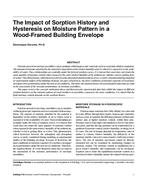Description
Moisture present in envelope assemblies can accumulate within hygroscopic materials such as wood and cellulose insulation. The amount of moisture adsorbed by the material is dependent on the relative humidity of air to which it is exposed or to the availability of water. These relationships are available under the form of sorption curves. It is known that wood does not retain the same quantity of moisture content when exposed to the same relative humidity of the ambient air, whether wood is getting drier or wetter. This phenomenon, called hysteresis between the adsorption and desorption curves, is rarely considered during modeling or experimental studies of the building envelope. Because of hysteresis, the prior conditions of moisture exposure of wood have an impact on its performance under the next set of conditions. Therefore, the sorption history of wood should be taken into account in the assessment of the moisture performance of envelope assemblies. This paper reviews the concepts mentioned above and then presents experimental data that exhibit the impact of different sorption histories on the moisture pattern of wood members in assemblies exposed to the same conditions. It is shown that the final moisture content depends on the sorption history.
Authors: Dominique Derome, Ph.D.
Citation: Thermal Performance of the Exterior Envelopes of Buildings VIII
Keywords: December, Florida, 2001
Citation: Thermal Performance of the Exterior Envelopes of Whole Buildings VIII
Product Details
- Published:
- 2001
- File Size:
- 1 file , 310 KB
- Product Code(s):
- D-8027




